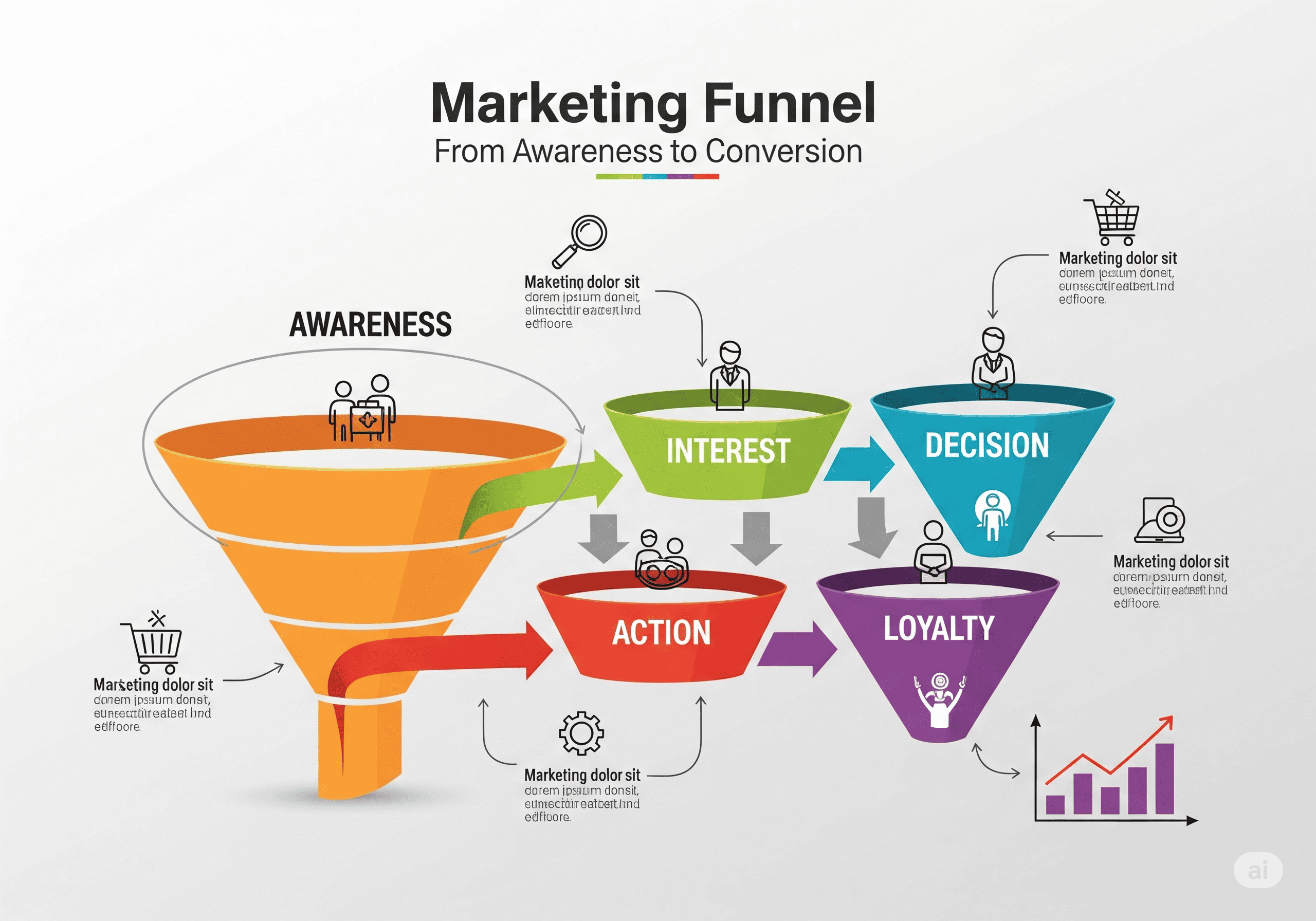Address
E-Learning
Worldwilde
Address
E-Learning
Worldwilde

Learn the essentials of building a marketing funnel that converts!
Are you pouring effort into your marketing, but struggling to turn casual website visitors into loyal customers? The missing piece might be a well-structured marketing funnel. Far more than just a sales process, a well-designed funnel acts as your 24/7 conversion engine, guiding prospects from initial awareness all the way to becoming happy clients.
This guide will provide you with a clear framework for building a marketing funnel from the ground up, designed to attract, engage and convert your ideal audience. We’ll break down each crucial stage, reveal key measurement metrics, and arm you with the knowledge to avoid common pitfalls.
Imagine a literal funnel: wide at the top, narrow at the bottom. That’s essentially a marketing funnel. It represents the journey a potential customer takes with your business, from their first encounter to their ultimate purchase and beyond. It’s about systematically nurturing relationships and converting strangers into paying customers.
Every business, whether it knows it or not, has a marketing funnel. The goal is to make yours intentional, optimized, and highly effective.
Before you create a single piece of content, the most critical step in building a marketing funnel is deeply understanding your target audience.
Using examples like Warby Parker, successful businesses craft content with a specific purpose for each stage of the customer journey, directly addressing their audience’s needs at every step.
A well-designed marketing funnel typically has four core stages, though variations exist. Here’s how to guide your prospects through them:
This is the top of the funnel, where prospects first become aware of their problem and, ideally, your brand.
Once aware, prospects start actively researching solutions.
Prospects are now evaluating options and comparing your offerings to competitors.
The bottom of the funnel, where prospects are ready to make a purchase.
To optimize your funnel, you must measure its performance. Here are key metrics for each stage:
| Funnel Stage | Key Metrics to Track |
| Awareness | Website views, unique visitors, organic search rankings, social shares, follower growth. |
| Interest | Return visitors, time on page, bounce rate, newsletter sign-ups, lead magnet downloads. |
| Consideration | Email open rates, click-through rates, webinar attendance, demo requests, trial sign-ups. |
| Decision | Conversion rate (sales/leads), average order value (AOV), customer acquisition cost (CAC). |
Actionable Tip: Use tools like Google Analytics, your CRM, and email marketing platforms to track these metrics rigorously.
While paid advertising has its place, an organic content marketing funnel offers distinct long-term advantages:
Even with a solid plan for building a marketing funnel, beware of these common mistakes:
Building a marketing funnel is a journey, not a destination. It requires continuous analysis, optimization, and a deep understanding of your customer. By applying these principles, you can create a powerful system that consistently generates leads and sales for your business.
💡 Want a ready-to-launch funnel with tracking, nurturing, and email automation all done for you?
👉 Book a strategy call now or grab our watch our funnel here
What’s the most challenging stage of the marketing funnel for your business, and why? Share your thoughts in the comments below!
📩 Want to stay updated?
Join our free community and get notified when new tutorials, strategies, and resources drop.
#LeadGeneration #SalesFunnel #MarketingFunnel #OnlineBusiness #SimpleFunnels #HighConvertingFunnels #AppointmentFunnel #VSL #FunnelStrategy #DigitalMarketing #CalendlyFunnel #ConversionOptimization OnlineBusiness #DigitalMarketing #MarketingStrategy #EntrepreneurLife #OnlineMarketing #MarketingTips #SmallBusinessOwner #BusinessGrowth #EmailMarketing #SocialMediaMarketing #MarketingAutomation #ContentMarketing #DigitalBusiness #FunnelHacking #ClientAcquisition #MetaADS